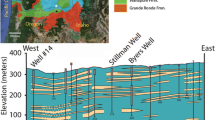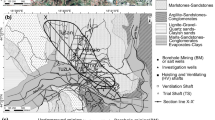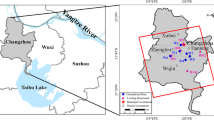Abstract
During 1992–2007, excessive pumping of groundwater caused large-scale aquifer-system compaction and land subsidence in the Choshui River Alluvial Fan, especially in the area of Yunlin county. The subsidence impedes surface-water runoff and endangers the operation of Taiwan High Speed Rail. Leveling, Global Positioning System (GPS), multi-level compaction monitoring well, and Differential Interferometric Synthetic Aperture Radar (DInSAR) are used to study the extent of subsidence in Yunlin and its mechanism. These sensors complement each other in spatial and temporal resolutions. A leveling network totaling 434 km in length was deployed to derive subsidence at every 1.5 km along the routes, and the result is accurate to few mm and shows a basin-like subsidence pattern centering at Tuku Township. Four multi-level compaction monitoring wells, co-located with GPS pillars, detect compactions at different depths, showing that the aquifer-system compaction (the cause of subsidence) occurs mostly below depths >200 m, where reduction of groundwater pumping is most needed. The vertical displacements from GPS and leveling agree to within 1 cm, and are larger than the cumulative compaction detected by the compaction-monitoring wells, suggesting that compaction also occurs below 300 m (the depth of the wells). The vertical displacements derived using DInSAR and 8 ENVISAT SAR images agree with the leveling result to 1–2 cm.

















Similar content being viewed by others
References
Amelung F, Galloway DL, Bell JW, Zebker H (1999) Sensing the ups and downs of Las Vegas: InSAR reveals structural control of land subsidence and aquifer-system deformation. Geology 27(6):483–486
Baarda W (1968) A testing procedure for use in geodetic networks. Netherlands Geodetic Commission. Publ. on Geodesy, 2(5), Delft
Bell JW, Amelung F, Ramelli AR, Blewitt G (2002) Land subsidence in Las Vegas, Nevada, 1935–2000: new geodetic data show evolution, revised spatial patterns, and reduced rates. Environ Eng Geosci 8(3):155–174
Berardino P, Fornaro G, Lanari R, Sansosti E (2002) A new algorithm for surface deformation monitoring based on small baseline differential SAR interferograms. IEEE Trans Geosci Remote Sens 40(11):2375–2383
Beutler G, Brockmann E, Dach T, Fridez P, Gurtner W, Hugentobler U, Johnson J, Mervart L, Rothacher M, Schaer S, Springer T, Weber R (2001) Bernese GPS Software Version 4.2, Astronomical Institute, University of Berne, Bern, p 515
Central Geological Survey of Taiwan (CGS) (1999) The investigation of hydrogeology in the Choshui River alluvial fan. CGS Publications, Taipei, p 130 (in Chinese)
Chen CW, Zebker HA (2002) Phase unwrapping for large SAR interferograms: statistical segmentation and generalized network models. IEEE Trans Geosci Remote Sens 40:1709–1719
Diapason (2006) Automated interferometric processing software version 4.0, Altamira Information, France
Ferretti A, Prati C, Rocca F (2001) Permanent scatterers in SAR interferometry. IEEE Trans Geosci Remote Sens 1(39):8–20
Galloway DL, Hoffmann Jörn (2007) The application of satellite differential SAR interferometry-derived ground displacements in hydrogeology. Hydrogeol J 15(1):133–154. doi:10.1007/s10040-006-0121-5
Galloway DL, Hudnut KW, Ingebritsen SE, Phillips SP, Peltzer G, Rogez F, Rosen PA (1998) Detection of aquifer-system compaction and land subsidence using interferometric synthetic aperture radar, Antelope Valley, Mojave Desert, California. Water Resour Res 34:2573–2585
Galloway D, Jones DR, Ingebritsen SE (1999) Land subsidence in the United States. Reston, Virginia, p 177
Hasanuddin ZA, Djaja R, Darmawan D, Hadi S, Akbar A, Rajiyowiryono H, Sudibyo Y, Meilano I, Kasuma MA, Jahar J, Subarya C (2001) Land Subsidence of Jakarta (Indonesia) and its Geodetic Monitoring System. Nat Hazards 23:365–387
Hoffmann J (2003) The application of satellite radar interferometry to the study of land subsidence over developed aquifer systems. PhD thesis, Stanford University
Hoffmann J, Galloway DL, Zebker HA, Amelung F (2001) Seasonal subsidence and rebound in Las Vegas Valley, Nevada, observed by synthetic aperture radar interferometry. Water Resour Res 37:1551–1566
Hoffmann J, Galloway DL, Zebker HA (2003) Inverse modeling of interbed storage parameters using land subsidence observations, Antelope Valley, California. Water Resour Res 39(2):1031. doi:10.1029/2001WR001252
Hooper AZ, Howard SP, Kampes B (2004) A new method for measuring deformation on volcanoes and other natural terrains using InSAR persistent scatterers. Geophys Res Lett 31:23611. doi:10.1029/2004GL021737
Hooper A, Segall P, Zebker H (2007) Persistent scatterer interferometric synthetic aperture radar for crustal deformation analysis, with application to Volca′n Alcedo, Gala′pagos. J Geophys Res 112. doi:10.1029/2006JB004763
Hung WC (2007) Taiwan land subsidence monitoring and surveying analysis, Report of Industrial Technology Research Institute (ITRI), Hsinchu (in Chinese)
Hung WC, Peng MH, Liu JK (2000) The result of installing a GPS continuous station. In: Proceedings of the 19th survey symposium, Taiwan (in Chinese), pp 84–93
Hwang C, Hsiao YS (2003) Orthometric correction from leveling, gravity, density and elevation data: a case study in Taiwan. J Geod 77:279–291
Hwang C, Hung WC, Liu CH (2008) Results of geodetic and geotechnical monitoring of subsidence for Taiwan High Speed Rail operation. Nat Hazards. doi:10.1007/s11069-007-9211-5
Lin LH, Lin HR, Ke AHW, Chou TH (1992) Petroleum potential of the Pre-Miocene Formations in the Chianan Plain, Taiwan. Petrol Geol Taiwan 27:177–197
Liu CW, Lin WS, Shang C, Liu SH (2001) The effect of clay dehydration on land subsidence in the Yun-Lin coastal area, Taiwan. Environ Geol 40(4/5):518–527
Marfai MA, King L (2007) Monitoring land subsidence in Semarang, Indonesia. Environ Geol 53:651–659
Massonnet D, Feigl KL (1998) Radar interferometry and its application to changes in the Earth’s surface. Rev Geophys 36:441–500
Pathier E (2003) Apports de l’interférométrie radar différentielle à l’étude de la tectonique active de Taiwan. PhD thesis, Univ. Paris VI. Paris, France, p 273
Peng MH, Shih TY (2002) A quality assurance approach for land subsidence interpolation. Survey Rev 36(286):568–581
Pietro LT, Laura T, Frankenfield CJ (2007) A new project to monitor land subsidence in the northern Venice coastland (Italy). Environ Geol 52:889–898
Population Division, Department of Economic and Social Affairs, United Nations (2005). World Population Prospects: The 2004 Revision. United Nations
Tyan CL, Chang YM, Lin WK, Tsai MK (1996) The brief introduction to the groundwater hydrology of Choshui River alluvial fan. In: Proceeding of groundwater and hydrogeology conference in Choshui River Alluvial Fan, Taipei, Taiwan (in Chinese), pp 207–221
UNAVCO (University NAVASTAR Consortium) (1999). In Continuous Station Equipment\Monumentation from http://unavco/www.unavco.ucar.edu/index.htm
Zebker HA, Rosen PA, Goldstein RM, Gabriel A, Werner CL (1994) On the derivation of coseismic displacement fields using differential radar interferometry: the Landers earthquake. J Geophys Res 99(19):617–619 634
Acknowledgments
This study is supported by the National Science Council (Project number: 96-2221-E-009-165) and the Water Resource Agency, Dept of Economics, Taiwan, ROC.
Author information
Authors and Affiliations
Corresponding author
Rights and permissions
About this article
Cite this article
Hung, WC., Hwang, C., Chang, CP. et al. Monitoring severe aquifer-system compaction and land subsidence in Taiwan using multiple sensors: Yunlin, the southern Choushui River Alluvial Fan. Environ Earth Sci 59, 1535–1548 (2010). https://doi.org/10.1007/s12665-009-0139-9
Received:
Accepted:
Published:
Issue Date:
DOI: https://doi.org/10.1007/s12665-009-0139-9




